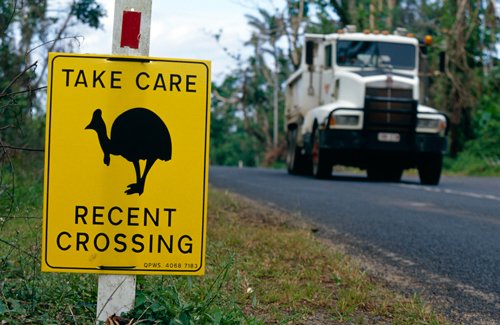Cassowaries hit hard by cyclone aftermath

MISSION BEACH’S FAMOUS CASSOWARY population will struggle in the coming weeks as fruit smashed to the ground during Cyclone Yasi begins to rot.
The birds’ habitat in the wet tropics rainforest, that hugs Mission Beach, has been ripped to shreds, and the canopy has disappeared leaving the birds exposed to the elements.
Yasi may have killed cassowaries
Tully vet Graham Lauridsen says some may have been killed. “We were able to look after the cassowaries following Cyclone Larry and we’ve learnt a lot as a result of that, so we’ll need to apply that expertise,” he says. “We know that some of these cassowaries would have perished, especially at this time of year when there are lots of chicks around.”
Now that the immediate threat of the cyclone has passed, possible deaths from starvation are not expected to be seen for another month or more, or when fallen fruit rots away. “In a month or six weeks time,” Graham says.
The Mission Beach cassowary population which ranges anywhere between 40 and 200 is one of the healthiest in Australia, but the species is still listed as endangered in Queensland and vulnerable on the IUCN Red List.
After Cyclone Larry in 2005, about one-third of the cassowary population perished from starvation.
Cassowaries an iconic species
The State government said wildlife officers were due to visit the ground on Monday examining the cyclone’s impact on cassowary rainforest habitat. “We haven’t made a clear decision about whether we will establish feeding stations again, but of course it will be on the table,” Queensland Environment minister Kate Jones says.
Bob Irwin, father of late wildlife warrior Steve Irwin, has also launched a campaign to save the cassowaries, as has conservation group, Rainforest Rescue.
They have become iconic for the region, and the local council even uses the name in its title, The Cassowary Coast Regional Council. Locals are protective of the cassowaries and some are doing their bit to help. Rob Jeffrey says the birds are highly territorial and he has been feeding one of two that live on his two acre property. “I’ve been looking after the male but I haven’t seen the female since the cyclone hit,” Rob says. “I know they’re resilient. They’ve been handling this for the last thousand years.”
Steph Curnuck owns a caravan park that backs on to a cassowary corridor. She says all the locals love the birds: “I don’t think I know of anyone, even if they’re not part of the green scene, who wants to see harm come to them, they’re such beautiful creatures.”

A truck passes a warning sign in Mission Beach, Qld (Photo: Jason Edwards/Getty).
Huge road signs dot the road into the town every two kilometres telling visitors to slow down and avoid collision with the large birds. Anneke Begraaf from the Save the Cassowary campaign said one of the dangers will be collisions with cars when the birds start straying to find their next feed.
“People will be pre-occupied on the road…and not paying attention to cassowaries,” she says. “Another issue will be heat exhaustion. The big black birds now have little canopy for shade from the tropical sun, and water-holes used to cool down will have a lot of debris [in them].”
Cyclone Yasi putting other animals at risk
Graham says a concerted effort is needed to ensure some other endangered species, including and mahogany gliders, survive the coming months. His surgery had been caring for a number of birds, including species which normally live in coral cays a couple of hundred kilometres from the mainland, who were left exhausted by the storm.
“We’ve had a few in who are OK but have just been exhausted from flying against the wind for hours and hours,” he says. “But the birds at least can fly away in search of another food source, its a lot harder for things like scrub turkeys or wallabies and many of those are sadly just going to starve.”
Graham and his partners rushed to reopen their Tully surgery to ensure local animals were cared for. A number of stray cats and dogs have already been bought in and if their owners aren’t found they may have to be put down. The surgery had been inundated with injured dogs, but it wasn’t flying debris which was to blame in most cases. “Most people bunkered down with their pets during the cyclone,” he says. “But there are a lot of fences down so there are dogs just wandering around town getting into fights at the moment.”
RELATED STORIES




